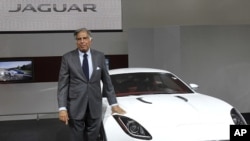For decades, compact cars was the buzzword for foreign and domestic automakers in India, but that trend appears to be shifting.
Big and expensive: those are the words that dominate new launches at the Delhi Auto Expo in the Indian capital.
Hyundai, Ford, Renault, Audi and Maruti Suzuki were among foreign and domestic auto companies that unveiled rugged sport-utility vehicles this week, to keep up with rising consumer demand.
Auto analyst Yogendra Pratap says the limelight is no longer on basic, cheap hatchbacks which automakers have sold for years.
“I think Indian people are considering buying cars that are more stylish, that have more features and are slightly bigger," Pratap said. "People are willing to pay for the extras, whether it be space, or it be utility or it be a modern and contemporary vehicle.”
While rising interest rates and more expensive fuel may have dampened sales of compact cars, they have not deterred more affluent customers from seeking out bigger vehicles.
Mohan Mariwala, managing director of Auto Hangar in Mumbai, sells Mercedes Benz cars. He says a luxury sedan is becoming an important symbol for a new generation with new aspirations.
“The buying age is getting younger, it is in fact the middle class which is aspiring to jump segments and get into these cars," Mariwala said.
Nonetheless, smaller cars are still firmly in the race in a country where car ownership is very low.
Four years after what is known as the world’s cheapest car, the Nano, hit roads in India and captured global attention, another ultra-small car has been unveiled.
The RE 60, made by Bajaj Autos, has a 200 cubic centimeter engine and a top speed of 70 kilometers per hour.
The company’s managing director, Rajiv Bajaj says the car will be in the market sometime this year. It is being pitched as a replacement for the popular three-wheeled taxis known as auto rickshaws, which can be seen on the streets of many Indian cities.
“We believe in the niche, we don’t believe in the rat races of volumes,” Bajaj said.
The car could emerge as a competitor to the Nano made by Tata Motors. Priced at about $ 2,700, the Nano was hailed as an example of low-cost innovation and promised to put four wheels in the hands of tens of thousands of people.
However, the Nano has not piled up the kind of success it had hoped to. Analysts say this is largely because of its image as a cheap car rather than an inspirational one.
Whether it be through the compact Nano or a luxury sport-utility vehicle, automakers are looking to turn around car sales in India, which was virtually stagnant last year despite 30 percent growth in 2010.
Auto analysts say sales could bounce back as early as next year, when the economy is expected to emerge from a slowdown.
Indian Automakers Look to Turn Around Slowing Market







